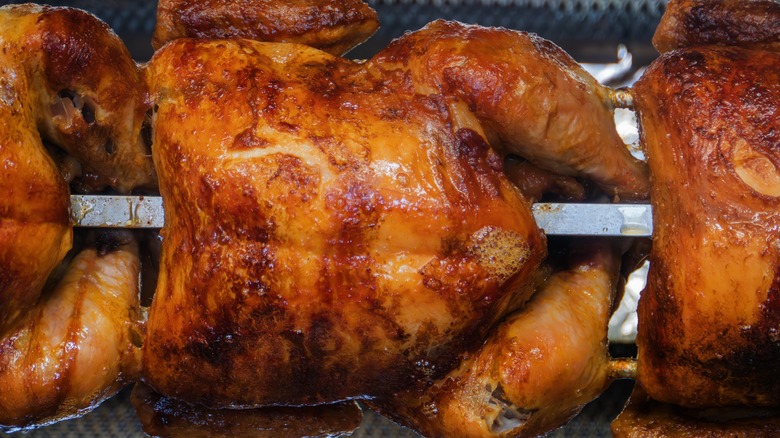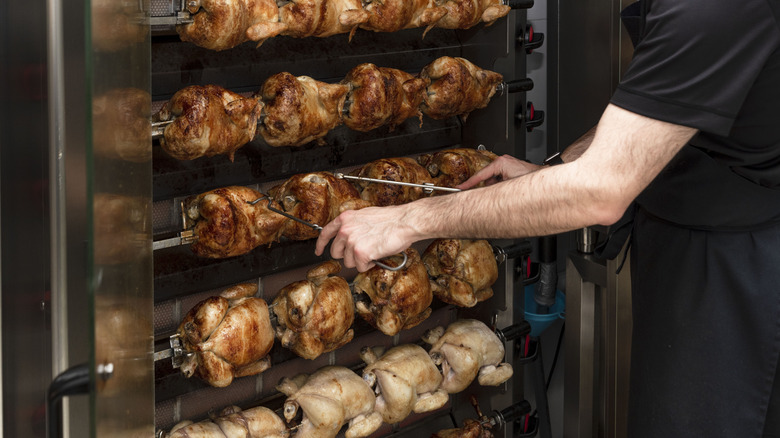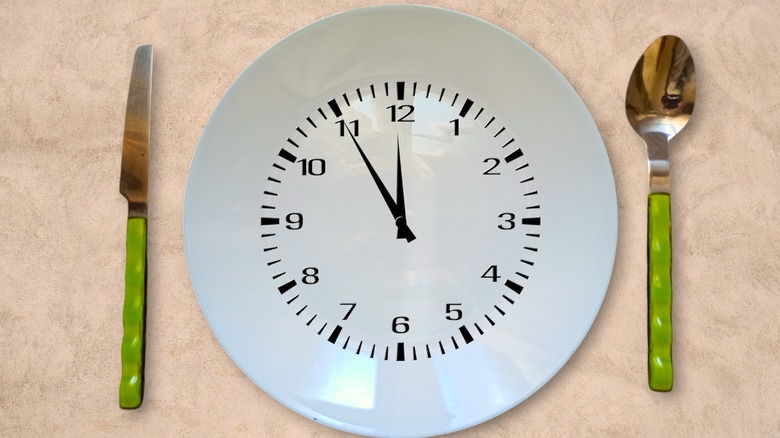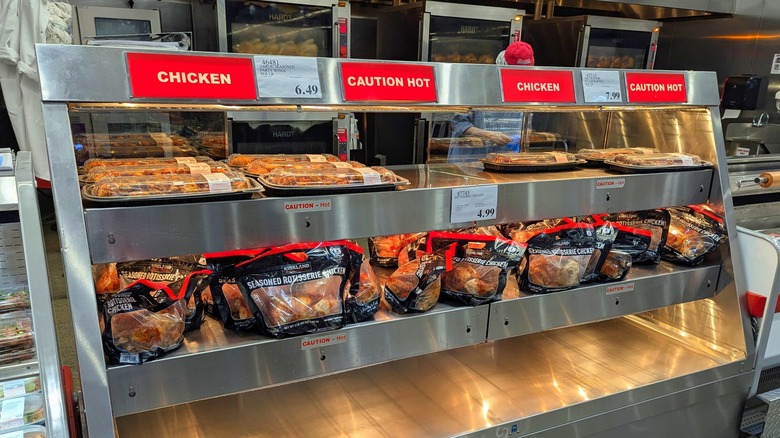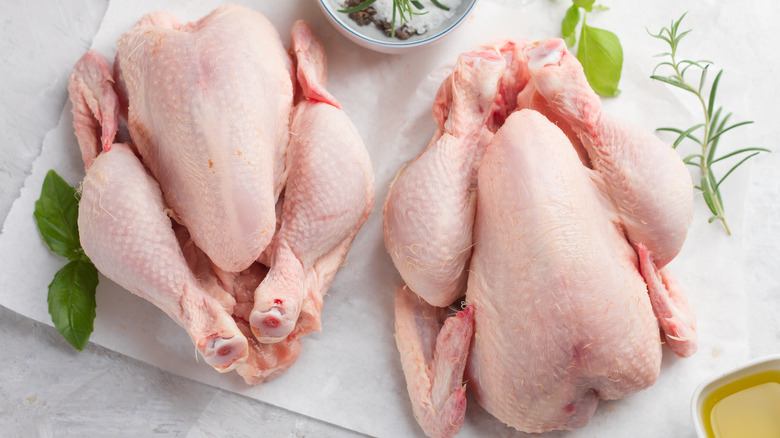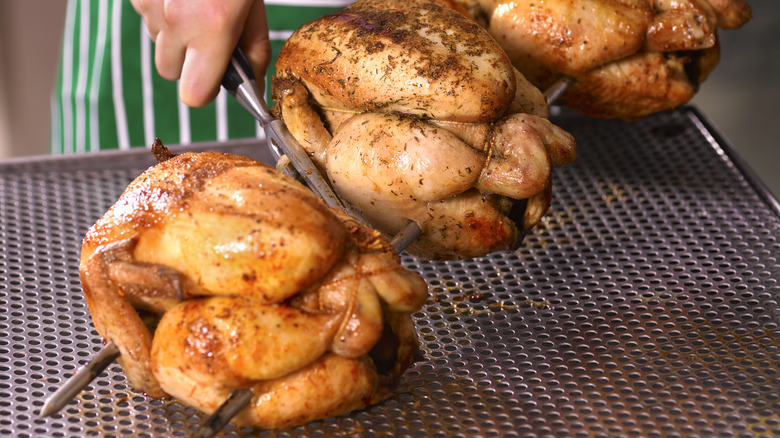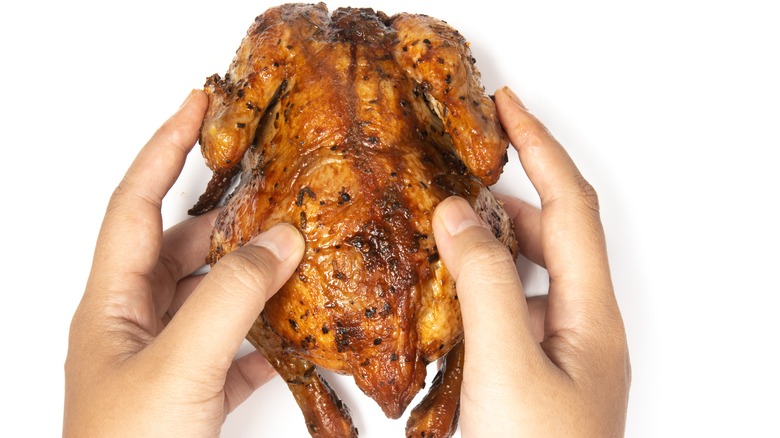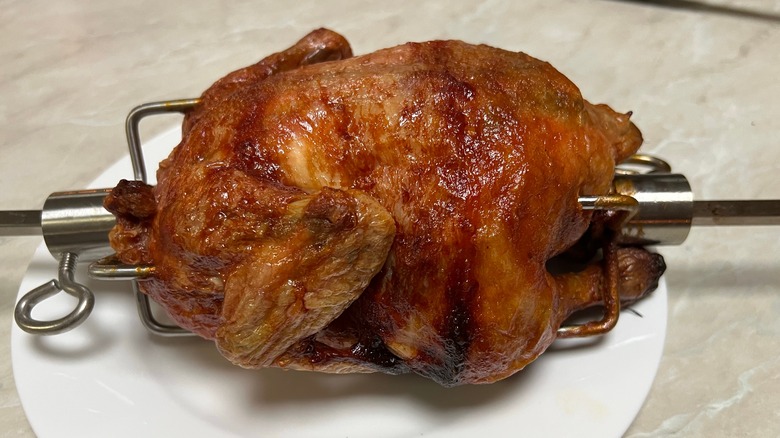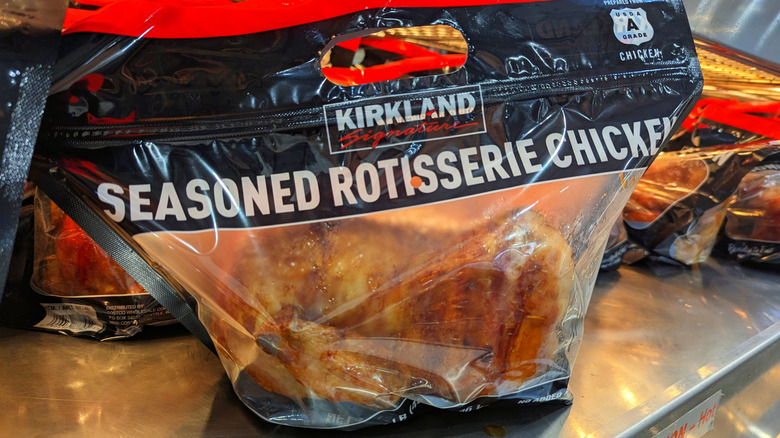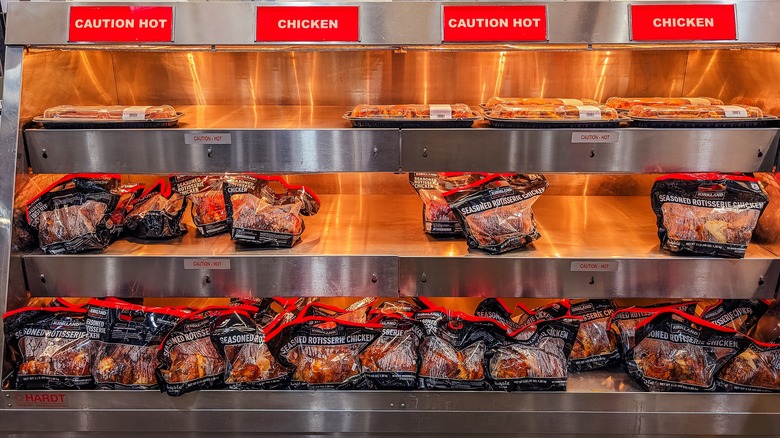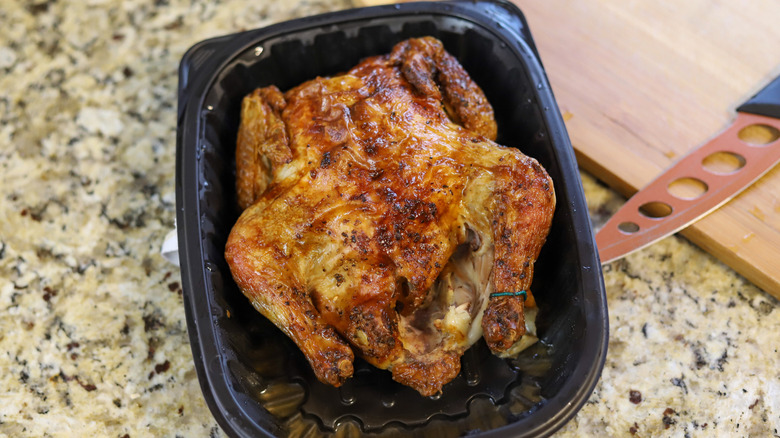Expert Tips For Choosing The Juiciest Rotisserie Chicken
There's something about spit-roasting that brings out the best in meat, but particularly chicken. It has evolved from labor-intensive work in front of roaring medieval fireplaces to specialist rotisserie equipment in stores that sell hundreds of golden-brown birds, week in, week out. In 2023 in Costco outlets in the United States alone, members bought 137 million rotisserie chickens. At $4.99 a pop for a succulent, pretty much-instant meal (that's also a nifty way for stores to minimize food waste) who can blame them?
Of course, lots of places sell rotisserie chickens, so although availability isn't an issue, getting your hands on a perfectly cooked, juicy bird can be another story. Questions we should ask include: Who is operating the rotisserie machine? Do the birds come with any hidden extras we should know about? How long are the chickens out of the oven before they're snapped up by hungry customers? Well, we have answers from experts Scott Groth, creator of I'd Rather Be a Chef, and Thomas Odermatt, founder of Butcher's Bone Broth. Here are 12 ways to make sure you're picking the juiciest rotisserie chicken.
Find a store that always sells out
Convenience underpins much of everyday life, but just because there's a store close by that churns out rotisserie chicken, doesn't mean they're worth having. Paying attention can reap delicious rewards. If you see the same cooked birds sitting for hours in a shop window without any passing locals buying them, it's probably wise for you to follow their example and move on.
"I've been to stores where the chickens are gone within 30 minutes of hitting the shelf — that's an indication that the chickens are delicious," said chef Scott Groth. As well as finding an outlet where rotisserie chickens fly out the door (pun intended), Groth also has a tip most shoppers don't use, but which can help them find a juicy bird: Talk to whoever is running the rotisserie section.
He believes good grocery stores will always go the extra mile to make sure shoppers take home the best products. Finding out when a batch was cooked or if what's on the spit will be coming out soon can ensure you get a juicy rotisserie chicken. "Maybe they would put one aside while you get your other shopping done," he said.
Find an outlet with trained oven operators
Lots of stores across the United States sell rotisserie chickens but not all ovens used to cook them are the same. There are electric and gas models, and they fall into two types: batch and continuous. Batch ovens start and finish all of the birds cooking inside them simultaneously, much like a traditional oven cooks a roast chicken. Continuous ovens are more flexible, and allow for rotisserie spits to be added or removed whenever the need arises. For chef Scott Groth, I'd Rather Be a Chef, getting a juicy rotisserie chicken comes down to the person doing the cooking.
Those who really understand the rotisserie oven and how the process works will turn out juicy and delicious chickens every time. Rotisserie or spit cooking slowly transfers external heat into the chicken, turning the collagen in the meat to gelatin which then mingles with fat and drips over the turned bird's surface. When it's done well, we end up with a crispy, golden rotisserie chicken that is bursting with savory juice. "If they aren't well trained and are just slamming chickens into the oven, even if they have the highest quality oven available, chances are good that the chicken isn't going to be great," Groth said.
Time your purchase right
Just as the smell of bread fresh out of the oven can lure us into a bakery, so the odor of rotisserie chicken wafting through a store often tempts us into splashing out on an easy dinner. If you want a juicy bird, however, timing your purchase is important.
Many grocery stores will cook their rotisserie chickens in batches to match peak shopping hours — usually around noon and 6 p.m., when many people are coming home from work. They use the wonderful smell of rotisserie chicken to prompt shoppers to act on impulse and buy one. If you time it right, you can bet a tasty, juicy bird is waiting for you.
However, it's worth remembering any chickens not sold after the noontime rush will sit under heat lamps for who knows how long. They may be warm, but their meat is more likely to be dry and unappealing. If the skin looks rubbery or wet, it's a telltale sign there's little juice left. Likewise, unsold chickens cooked after the dinner time rush will also stay under heat lamps until just before closing, when they are chopped up and used in chicken salads or other pre-prepared dishes. "If you see a rotisserie chicken in the display first thing in the morning, I would avoid it altogether," warned chef Scott Groth.
Check the timestamp
Nothing quite matches the thrill of hearing the bell in Costco that rings when a new batch of rotisserie chicken is up for grabs. But if you can't make that store's two-hour window, there are ways to make sure you can find a juicy rotisserie chicken that isn't fresh out of the oven.
Costco rotisserie chickens rarely stay on their shelves for long for two reasons: They're a snip at a penny under $5 and if they're unsold after two hours, those birds are shredded and turned into something tasty and tempting for shoppers. Other outlets might not have the same policy, so it's worth checking the timestamp on the label to figure out when your rotisserie chicken came out of the oven.
According to Thomas Odermatt, founder of Butcher's Bone Broth, the law states the hot holding unit for cooked meats needs to be at 165 F, so a chicken that has been out of the rotisserie oven for less than an hour is likely to be juicy and delicious. He recommends avoiding chickens that have been sitting around for four hours or more. "For that period of time, it is a sure thing to dry up to saw dust [sic]," he said.
Organic or non-organic: It's not always an issue
Consumer demand for organic chicken has boomed in recent years, growth that's not expected to slow down any time soon. More people want to eat chickens and other produce that contain fewer chemicals and, in the case of animals, want to know they enjoyed good standards of welfare before being slaughtered.
Butcher Thomas Odermatt admits he always goes for the highest label he can find when shopping for food, including rotisserie chicken. But how a chicken was reared doesn't necessarily guarantee it's going to taste better than one that was industrially farmed. As more stores offer organic rotisserie chickens, some more expensive than others, chef Scott Groth, I'd Rather Be a Chef, offers a controversial take: It doesn't matter whether the bird was free range or not.
He agrees that organic chickens have better flavor and overall texture, but just because the bird is organic, that doesn't mean it will be more tender or flavorful once it's been cooked. "Keep in mind that how the chicken is seasoned, cooked and stored can make or break any rotisserie chicken," Groth said.
Bigger isn't necessarily better
When it comes to food in the United States, everything from production to portions are often on a bigger scale than other countries. When shopping for a rotisserie chicken, it can be tempting to grab the largest one you see and head to the checkout, assuming it's going to be chock full o'juice. Unfortunately, a bigger bird isn't always better.
In some cases, larger birds are typically older and the meat often is less tender — but that's not all. According to chef Scott Groth, some chickens are injected with solutions to boost their weight, only for them to quickly drain out when they've been cooked, leaving us with lots of dry meat. He suggests opting for smaller birds, which are usually younger and more tender. "They cook faster on the rotisserie, allowing grocery stores to time their freshness with peak shopping hours," he said.
For Thomas Odermatt, Butcher's Bone Broth, size isn't a barrier to a perfectly cooked, juicy chicken, thanks to the electronic cooking probes inside many sophisticated rotisserie ovens. He does bring up an important point about minimizing waste by buying the right-sized bird. He encouraged shoppers to choose a chicken that can be eaten in one sitting. "If not, then you need to be ready to shred, cool, and store in the refrigerator," he said.
Feel the weight
There are several factors influencing what we buy. Brand name and price are among them, but what each person considers to be the best also plays an important role. For fresh produce, we can pinch, squeeze, or smell it ... but for a juicy rotisserie chicken, it's all about the heft.
If you happen to be passing by when the bell rings in Costco or when a fresh batch is removed at peak times in other stores, chances are the majority of chickens up for sale will be tasty and juicy. One quick trick can help you decide which one gets put in your shopping cart: Pick it up.
Most chickens are about the same size when they're cooked but some can be just a little heavier. Pick up a few of the bags or containers and compare them to find out which weigh more than others. Why? Because the heavier chickens tend to have retained their juice. Grab it fast before it all leaks into the container and run that tasty bird to the checkout.
Check skin color
Rotisserie chicken lovers are skin stans. It has a lot to say about the quality of the meat too, including how juicy it might be. Avoid birds with rubbery or wet-looking skin, as it suggests they've been under the heat lamps for a long time. Likewise, if the skin is torn, taut and paper thin, particularly around the thighs and legs, it's most likely overcooked and will lack juice.
If you want a juicy bird, chef Scott Groth encouraged shoppers to find an unseasoned chicken with a skin that's golden-brown, though it's not always a fool-proof method. He said: "Sometimes this color can be masked with seasonings like paprika, cumin, or dried mustard that brown beautifully."
Butcher Thomas Odermatt agreed. He said, "The color of the chicken skin is not always an indicator of juiciness — often rotisserie birds have paprika in their seasoning mix, which will make them darker." Odermatt's ideal chicken skin color is similar to that of mahogany wood, and he urges shoppers to check for a puddle of liquid around the bird to determine potential juice levels. "The color is no indication of what state the meat underneath is," he added.
Choose the packaging wisely
When Costco switched from their hard plastic packaging to paper bags in 2024, the move got a frosty response from customers, and some professionals too, including chef Scott Groth. "If it were up to me, we would take the rotisserie chickens out of the plastic packaging completely but that makes them really hard to sell and transport," he said.
Although they're better for the environment, rotisserie chickens sold in paper bags can become soggier than those in, say, plastic bags or containers. The rigid plastic packaging not only allows condensation to gather in the bottom of the shell, it doesn't touch the skin of the chicken. "The bag-style lets the condensation run onto the skin, often making it lose that crispness that everyone loves," Groth said.
Manufacturers appear to have noticed this issue and some bags now feature a much better venting system that allows steam to escape. For chef Thomas Odermatt, while the packaging doesn't have a direct impact on the bird's quality, dry meat from overcooking remains one of the biggest issues for store-bought rotisserie chickens.
Be wary of a long ingredients list
Many processed foods come with a laundry list of ingredients but fresh items, like rotisserie chickens, should have just a small handful. Sadly that's not always the case, so it's worth checking the label not just for a timestamp but also to find out what ingredients could be hiding in plain sight.
Seasonings, such as salt, pepper, mustard powder, cumin, and onion powder are nothing to be concerned about, as their purpose is often to boost the bird's flavor. However, if you see ingredients such as dextrose — a form of sugar – additives like modified food starch, or thickeners such as carrageenan or polysorbates on the label, alarm bells may start to go off.
"These are often used to enhance flavors or extend out the shelf life of the chicken," said I'd Rather Be a Chef's Scott Groth. "If the chickens are being cooked perfectly, there is no need for any of these ingredients as the birds will sell out every time." As far as chef Thomas Odermatt is concerned, the only addition a rotisserie chicken may need is a sauce whipped up from the rotisserie drippings in the packaging.
Choose your rotisserie chicken from the back
Fresh produce sellers do it. Organized home cooks do it, and so do rotisserie chicken managers: Everyone dealing with food puts the oldest stuff at the front, whether it's a display or a kitchen cupboard. It's an easy form of triage that prevents food from being kept past its use-by date, and if you're in the market for a juicy rotisserie chicken, it's an important tip to keep in mind.
"The biggest mistake is to grab the first rotisserie chicken that's in the front," said chef Scott Groth. As with fresh produce, whatever has been out the longest will be pushed to the front, in the hope that a customer in a hurry will pick it up and move on. The same applies to rotisserie chickens: The freshest are always at the back.
Groth noted that even being at the back of the line doesn't always guarantee getting the juiciest chicken. "The longer a cooked chicken has been sitting under the heat lamp, the more moisture it loses," he said. It's worth looking at the skin if you can see it through the packaging. He recommended avoiding birds with cracked, thin or dry-looking skin. Don't think that those juices at the bottom of a container lurking at the back of the row mean you've found a winner either: All that flavor should be in the bird.
Invert your rotisserie chicken when reheating
When you've picked the juiciest rotisserie chicken of the bunch, chef Thomas Odermatt's tip for keeping it that way until the moment it's eaten is simple: Turn it upside down. "I always immediately when coming home turn the chicken breast down (the chicken is best rested on its breast), and be sure to remove the juice from the bag and save it for later."
When it comes to reheating a rotisserie chicken, Odermatt recommended using an air fryer. Whether you want to crisp the chicken's skin or even some green veggies, the quick heat is ideal. Inverting is key to keeping the bird juicy: "It is crucial that you place the chicken breast flat and have the back of the chicken facing up. This will allow the juice from the back to seep down into the outer breast," he advised.
A hot rotisserie chicken must have an internal temperature of 165 F to be eaten safely, but if you want to keep some for later, take all the meat off the bones while it's still warm, cool it to room temperature, and then store in the fridge for four or five days. Chef Scott Groth gets maximum use from a rotisserie chicken by using the carcass and bones to make a tasty broth. "Roast the chicken carcass for about 25 minutes before adding it to the pot. The roasted bones add a depth of flavor that is just wonderful."
